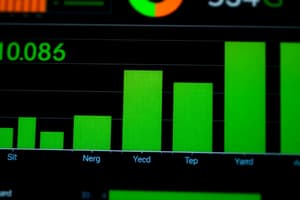Podcast
Questions and Answers
Which variable type is characterized by countable, exact values?
Which variable type is characterized by countable, exact values?
- Discrete variable (correct)
- Qualitative variable
- Continuous variable
- Nominal variable
What is a key characteristic of a continuous variable?
What is a key characteristic of a continuous variable?
- It is categorical in nature.
- It can assume an infinite number of values between two specific values. (correct)
- It is counted in whole numbers only.
- It has a finite number of possible values.
Which of the following is an example of a discrete variable?
Which of the following is an example of a discrete variable?
- The height of a tree in meters
- The weight of a bag of apples
- The number of cars in a parking lot (correct)
- The temperature of a room
How does a nominal level of measurement differ from other levels of measurement?
How does a nominal level of measurement differ from other levels of measurement?
Which type of data cannot be meaningfully arranged in an order?
Which type of data cannot be meaningfully arranged in an order?
What is the primary purpose of descriptive statistics?
What is the primary purpose of descriptive statistics?
Which of the following is an example of inferential statistics?
Which of the following is an example of inferential statistics?
What is the primary focus of the science of statistics?
What is the primary focus of the science of statistics?
A bowler wants to know his average for the past 6 months. What type of statistics would he be using?
A bowler wants to know his average for the past 6 months. What type of statistics would he be using?
Which of the following best describes a 'population' in statistics?
Which of the following best describes a 'population' in statistics?
A researcher studies the average height of all students in a university. What does the average height represent in this context?
A researcher studies the average height of all students in a university. What does the average height represent in this context?
A politician uses opinion polls to gauge his chances of winning an election. This is an example of:
A politician uses opinion polls to gauge his chances of winning an election. This is an example of:
Which statement from the SAT study example is descriptive in nature?
Which statement from the SAT study example is descriptive in nature?
What is the key difference between a parameter and a statistic?
What is the key difference between a parameter and a statistic?
In a study, a group of 500 people are selected at random from a larger population to participate in a survey. What does this group of 500 people represent?
In a study, a group of 500 people are selected at random from a larger population to participate in a survey. What does this group of 500 people represent?
Which of the following is NOT a characteristic of descriptive statistics?
Which of the following is NOT a characteristic of descriptive statistics?
Which of the following symbols correctly represents a sample mean?
Which of the following symbols correctly represents a sample mean?
A housewife wants to predict how much she'll spend on groceries this year based on last year's bills. What type of analysis would she be doing?
A housewife wants to predict how much she'll spend on groceries this year based on last year's bills. What type of analysis would she be doing?
Which of these would be considered a measure of central tendency?
Which of these would be considered a measure of central tendency?
If the population standard deviation is denoted by '𝝈', what is a common symbol used to denote the sample standard deviation?
If the population standard deviation is denoted by '𝝈', what is a common symbol used to denote the sample standard deviation?
What is the relationship between descriptive and inferential statistics?
What is the relationship between descriptive and inferential statistics?
Which of the following best describes a 'variable' in the context of data analysis?
Which of the following best describes a 'variable' in the context of data analysis?
Which of these is an example of a 'qualitative' variable?
Which of these is an example of a 'qualitative' variable?
Which of the following is considered a 'quantitative' variable?
Which of the following is considered a 'quantitative' variable?
The 'brand of cereal children eat for breakfast' is an example of what type of variable?
The 'brand of cereal children eat for breakfast' is an example of what type of variable?
The 'length of time billed for a long-distance telephone call' would be classified as:
The 'length of time billed for a long-distance telephone call' would be classified as:
Which of the following best describes ‘data’?
Which of the following best describes ‘data’?
If a researcher records the 'type of book taken out of the library by a student', they are collecting what type of data?
If a researcher records the 'type of book taken out of the library by a student', they are collecting what type of data?
A researcher measures 'the temperature in Antipolo, Rizal at 12:00 pm on any given day.' This variable is best described as:
A researcher measures 'the temperature in Antipolo, Rizal at 12:00 pm on any given day.' This variable is best described as:
Which level of measurement allows for meaningful differences between data points but lacks a true zero point?
Which level of measurement allows for meaningful differences between data points but lacks a true zero point?
If data can be categorized and ranked, but precise differences between the ranks do not exist, which level of measurement is being used?
If data can be categorized and ranked, but precise differences between the ranks do not exist, which level of measurement is being used?
What is a key characteristic of ratio data that distinguishes it from interval data?
What is a key characteristic of ratio data that distinguishes it from interval data?
Classifying a group of people by their political party affiliations (e.g., Democratic, Republican, Independent) is an example of what level of measurement?
Classifying a group of people by their political party affiliations (e.g., Democratic, Republican, Independent) is an example of what level of measurement?
Which of the following is an example of ordinal data?
Which of the following is an example of ordinal data?
What level of measurement is used when measuring temperature in Fahrenheit?
What level of measurement is used when measuring temperature in Fahrenheit?
Which of the following is an example of ratio data?
Which of the following is an example of ratio data?
The key difference between interval and ordinal data is that interval data has:
The key difference between interval and ordinal data is that interval data has:
Which of the following variables is an example of ordinal level data?
Which of the following variables is an example of ordinal level data?
Which variable represents ratio level data?
Which variable represents ratio level data?
Which of the following is an example of nominal level data?
Which of the following is an example of nominal level data?
What type of data is represented by 'Years of important historical events'?
What type of data is represented by 'Years of important historical events'?
Which of these variables is considered qualitative?
Which of these variables is considered qualitative?
Flashcards
Statistics
Statistics
The science of planning studies and experiments, obtaining data, and then organizing, summarizing, presenting, analyzing, interpreting, and drawing conclusions based on the data.
Population
Population
A complete collection of individuals or objects or events whose properties are to be analyzed.
Sample
Sample
A sub collection of members selected from a population, used to represent the whole population.
Parameter
Parameter
Signup and view all the flashcards
Statistic
Statistic
Signup and view all the flashcards
Descriptive Statistics
Descriptive Statistics
Signup and view all the flashcards
Inferential Statistics
Inferential Statistics
Signup and view all the flashcards
Variable
Variable
Signup and view all the flashcards
Data
Data
Signup and view all the flashcards
Qualitative Variable
Qualitative Variable
Signup and view all the flashcards
Quantitative Variable
Quantitative Variable
Signup and view all the flashcards
Discrete Variable
Discrete Variable
Signup and view all the flashcards
Continuous Variable
Continuous Variable
Signup and view all the flashcards
Qualitative Variable
Qualitative Variable
Signup and view all the flashcards
Quantitative Variable
Quantitative Variable
Signup and view all the flashcards
Nominal Data
Nominal Data
Signup and view all the flashcards
Ordinal Data
Ordinal Data
Signup and view all the flashcards
Interval Data
Interval Data
Signup and view all the flashcards
What are descriptive statistics?
What are descriptive statistics?
Signup and view all the flashcards
What are the key components of descriptive statistics?
What are the key components of descriptive statistics?
Signup and view all the flashcards
What are inferential statistics?
What are inferential statistics?
Signup and view all the flashcards
What's the purpose of inferential statistics?
What's the purpose of inferential statistics?
Signup and view all the flashcards
What is the difference between descriptive and inferential statistics?
What is the difference between descriptive and inferential statistics?
Signup and view all the flashcards
Give an example of descriptive statistics.
Give an example of descriptive statistics.
Signup and view all the flashcards
Give an example of inferential statistics.
Give an example of inferential statistics.
Signup and view all the flashcards
Which statements from SAT score example are descriptive and which are inferential?
Which statements from SAT score example are descriptive and which are inferential?
Signup and view all the flashcards
Nominal Level Data
Nominal Level Data
Signup and view all the flashcards
Ordinal Level Data
Ordinal Level Data
Signup and view all the flashcards
Interval Level Data
Interval Level Data
Signup and view all the flashcards
Ratio Level Data
Ratio Level Data
Signup and view all the flashcards
Nominal Scale
Nominal Scale
Signup and view all the flashcards
Ordinal Scale
Ordinal Scale
Signup and view all the flashcards
Interval Scale
Interval Scale
Signup and view all the flashcards
Ratio Scale
Ratio Scale
Signup and view all the flashcards
Nominal Level
Nominal Level
Signup and view all the flashcards
Ordinal Level
Ordinal Level
Signup and view all the flashcards
Interval Level
Interval Level
Signup and view all the flashcards
Ratio Level
Ratio Level
Signup and view all the flashcards
Study Notes
Introduction to Statistics
- Statistics is the science of planning studies and experiments, collecting data, organizing, summarizing, presenting, analyzing, interpreting, and drawing conclusions based on the data.
- Descriptive statistics summarize a given data set, representing either an entire population or a sample.
- Inferential statistics use sample characteristics to draw conclusions about a population.
Learning Targets
- Define statistics
- Differentiate types of statistics
- Define basic terms in statistics (population, sample, parameters, statistics, data, variable, qualitative variables, quantitative variables)
- Understand continuous and discrete variables
- Identify four levels of measurement
- Provide examples for each level of measurement
- Differentiate four levels of measurement
Population and Sample
- Population: A complete collection of individuals, objects, or events whose properties are to be analyzed.
- Sample: A subset of the population selected for study.
Population vs. Sample
- The slides show a visual representation of the difference between a target population and a sample.
Parameter vs. Statistic
- Parameter: A numerical value summarizing all data of an entire population.
- Statistic: A numerical value summarizing sample data.
- Examples of parameters and statistics are given in a table.
Data and Variables
- Data: Values of a variable (e.g., measurements, responses).
- Variables: Characteristics, numbers, or quantities that can be measured or counted about each element of a population or sample.
- Types of variables: Qualitative (categorical) and Quantitative (numerical).
- Examples of variables are given in a list.
2 Types of Variables
- Qualitative Variables: Have distinct categories based on a characteristic or attribute (e.g., gender, colors, brands).
- Quantitative Variables: Are numerical and can be measured or counted.
- Discrete variables (exact numbers, counted)
- Continuous variables (can assume infinite values between any two values, obtained by measurement)
Qualitative vs. Quantitative Data
- Qualitative data are observed through senses. Quantitative data are obtained using instruments, providing measurable numbers. Descriptive and the inferential scenarios are shown in table format.
Levels of Measurement
- Four levels of measurement: Nominal, Ordinal, Interval, Ratio.
Nominal
- Categorical data (names, labels, or categories only).
- No meaningful order to the categories. (e.g., city of birth, gender, eye color).
Ordinal
- Categorical data with a meaningful order.
- Differences between categories aren't necessarily equal. (e.g., rankings, satisfaction levels).
Interval
- Numerical data with meaningful differences between values.
- No true zero point (e.g., temperature in Celsius or Fahrenheit).
Ratio
- Numerical data with meaningful differences and a true zero point.
- Ratios between values are meaningful. (e.g., height, weight, time, age)
Examples of Levels of Measurement (table)
- Examples of each data type are demonstrated.
Studying That Suits You
Use AI to generate personalized quizzes and flashcards to suit your learning preferences.




